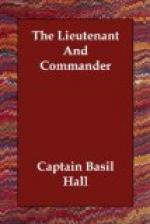The position of this margin or southern edge, which in technical language is called the equatorial limit of the Trade, varies considerably with the season of the year. From December to May inclusive it frequently reaches as far as the 3rd degree of north latitude, though it ranges about 5 deg. and 6 deg. north. From June to November it is shifted back as far, sometimes, as 13 deg. north, but it seldom extends as far south as 8 deg. north. Subjects which are treated of in a series of tables showing the equatorial limits of both Trade-winds, deduced by the late Captain James Horsburgh, hydrographer of the East India Company, from the observations of 238 ships. These tables show very clearly the effect of the absence or presence of the sun in shifting the limits of the Trades, drawing them after him, as it were. The presence of the sun in either hemisphere obstructs considerably the regularity and strength of the Trade-winds in that hemisphere, and vice versa.
The great difficulty experienced in making the outward-bound voyage commences after the ship has been deserted by the north-east Trade, for she has then to fight her way to the southward across the region of Calms and Variables. But as these Variables blow generally from the southward and westward, from a cause afterwards to be explained, it is obvious enough why this part of the homeward voyage is always more easily made than the outward passage. These southerly breezes, which are met with in the Variables, blow at times with considerable force, and greatly perplex the young navigator, who, trusting perhaps to some of the erroneous published accounts, not unnaturally reckons upon meeting the regular Trade-wind, blowing, as he supposes, from the east near the equator, not from the south; still less is he prepared or pleased to find it blowing from the south-westward.
This troublesome range, intervening between the two Trades, varies in width from 150 to more than 500 miles. It is widest in September, and narrowest in December or January. I now speak more particularly of what happens in the Atlantic. In the wide Pacific, far from land, fewer modifying circumstances interfere with the regular course of the phenomena, than in the comparatively narrow sea formed by the opposite shoulders of Africa and South America.




